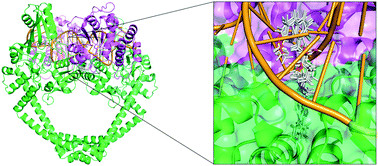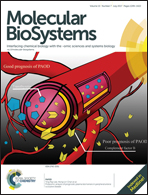Structure-based design of novel combinatorially generated NBTIs as potential DNA gyrase inhibitors against various Staphylococcus aureus mutant strains†
Abstract
Although intercalating agents such as quinolones have had proven therapeutic success as antibacterial agents for more than 40 years, new forms of quinolone-based resistance in bacteria are continually emerging. To alleviate this problem, a new class of antibacterials is urgently needed; recently, novel bacterial topoisomerase inhibitors (NBTIs) have been found to be particularly important. Based on 67 experimentally evaluated NBTIs against wild-type (WT) DNA gyrase originating from Staphylococcus aureus, a predictive QSAR model was initially constructed and validated and was later used for in silico prediction of biological activities for an in house designed compound library of 548 novel drug-like NBTI combinatorial analogs. To evaluate the influence of gyrA alterations on NBTI resistance, various mutant homology models were constructed; meanwhile, their resistance profiles were assessed and validated relative to that of WT enzyme by structure-based virtual screening (VS) of known NBTIs. Surprisingly, the M121K mutant model was recognized as the most selective due to an additional established cation–π interaction between K121-NH3+ (not found in the WT) and the aromatic moiety of the NBTI right-hand site (RHS) fragment; this finding was additionally supported by VS of our combinatorially generated NBTIs. Moreover, we identified several attractive, synthetically feasible RHS building blocks that may enable the development of new NBTIs.



 Please wait while we load your content...
Please wait while we load your content...